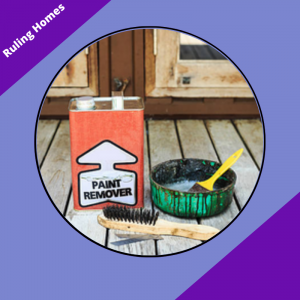Paint remover breaks the bond between the hard surface and the solvent and removes the extra coatings with a perfect finish.
The common material used in paint remover is dichloromethane, also called methylene chloride. It also comes with ammonia, acetone, and other solvents. The solvent type directly configures the price and functioning of the paint remover.
It comes in a compact pack of synthetic plastic or metal to keep the remover safe from moisture. It is effective in removing paint, leaving a significant amount of smell, not safe for kids.
The paint remover with dichloromethane lasts longer than any other type as it removes the paint from hard surfaces easily. The price of the paint remover depends on the results. A paint remover with a high amount of acetone and ammonia is a good option, depending on what type of surface you want to remove the hard coatings.
The history of paint remover is not too old. People were using different chemicals like acid and alkaline mixtures to remove the hard coatings of paint from the surface.
It led to the invention of a special solvent-based mixture of strong chemicals like ethanol, methyl chloride, and acetone. It helped the workers in the quick removal of paint from hard surfaces like metal, wood and iron.
The exact time of invention and person is not known, but it is a widely used method of removing paint from different surfaces.
Table of Contents
What is the ideal material for paint remover?
The ideal material for paint remover is dichloromethane. It is preferred because of its strong stripping and long-lasting properties.
Dichloromethane-based paint remover costs more than other types. The cheapest type one is with acetone, which is only applicable to a few surfaces like metal and steel.
The longevity and reliability of the paint remover are determined by its usage. Also, the surface on which you want to apply the paint remover is equally important to test its functionality.
People concerned about environmental health might want to consider the paint remover that produces fewer fumes in the air. The fumes are produced by the strong chemicals in paint remover (poses a serious harm to eyes and breathing system).
What are the types of paint removers?
There are three major types of paint remover.
Solvent-based paint remover: It consists of a solvent that effectively breaks the bond between the object and paint. It works by weakening the cohesion of the paint. In this way, paint is removed from any surface.
Caustic-based paint remover: It consists of a mixture that works slightly different from solvent-based. It works by breaking down the chemicals in the paint as they have a strong pH level.
Biochemical-based paint remover: It is completely different from both categories. It performs the function by using chemicals derived from different plants. It also works by breaking the strong bond of paint and surface.
What is the ideal size of the paint remover?
The ideal size of the paint remover depends on the area you want to cover. It works differently for residential and commercial purposes. You will require more bags of paint remover for the big area.
What size paint remover do I need? It depends on the area you want to cover. First, you need to check how often youneed to remove the paint from the surface. Normally, paint remover is used when you desire to change the color scheme or if it is partially removed from the surface.
Typically, a 10-liter paint remover bag is enough for a 500 square feet area. If you tend to remove the paint from a bigger area, you will require more bottles of paint remover.
You might also want to consider the price of the paint remover before making your buying decision. Material of the paint remover and its quantity are the important factors to consider.
What are the use cases of a paint remover?
A use case of paint remover can be described as a specific way you can use it in your house or commercially. Some other use cases of paint remover are given below.
- Removes hard coatings of paint efficiently
- Clean the surface to maximum
- Prevents corrosion by the oily mixture
- Save the surface from moisture
- Efficiently cleans the underlying surface
Once you have used the paint remover, you will know more use cases of this product.
Is paint remover safe to use?
If it is not used with proper safety measures, paint remover can be hazardous to your health.
How fast does paint remover work?
It removes the paint from the hard surface and brings back the object’s original surface in 15-20 minutes.
Should I use paint remover before painting?
Yes, you can use the paint remover before painting, as it will make the surface fresh and ready to paint.
Can we use paint remover on concrete surfaces?
Yes, you can remove the paint from the concrete surface using the standard paint remover.
Does the paint remover leave color after the application?
It depends on the quality of the paint remover. Normally there is a 95% chance that the paint remover won’t leave any color on the surface.
What are the best paint remover brands?
The best paint remover brands so far are:
Best value paint remover: Dumond
Best overall paint remover: D Super Remover
Best cost-friendly paint remover: Citristrip
Best cost-effective paint remover: KLEAN Strip
What is the lifespan of a paint remover?
The average life span of paint remover is not known. There is little or almost no evidence that paint remover expires as far as its box is airtight and sealed when not in use. The chemicals present in the paint remover mixture increase the lifespan.
Some other factors on which the lifespan of paint remover depends:
- Proper temperature
- Storage
- Climate change
- Moisture and humidity interaction
The average cost of paint remover varies from $5-$150, which does not include the labor. The paint remover used in big buildings and houses will cost more because of their enormous size.
How does culture affect the usage of paint remover?
Paint remover took off to the market right after its invention. People found it easy to remove the paint from a hard surface. Paint remover proved to be an updated product to remove paint without damaging the original quality of the surface.
Paint remover serves different purposes in different regions of the world. It allows the user to change the color scheme of their house frequently. Some people also use it to remove epoxy flooring and latex surface.
What are the alternatives for a paint remover?
Baking soda: It works similarly to a paint remover. Both are used to remove paint from hard surfaces. Baking soda works perfectly fine for metal surfaces. Add ¼ water to the baking soda to extract its maximum capability.
Heat waves technology: It also works like the paint remover. Both are efficient in removing hard coatings of paint. Heat waves weaken the bond of paint with the surface and with the help of a scrapper, you can rip off the hard coatings of paint.
What are the features of a superior paint remover?
Some of the best features of paint remover are:
Maintain the original surface: Even if you have applied strong chemicals to the surface. A good paint remover will ensure the original quality of the surface.
Environment friendly: High-quality paint remover is a friend of the environment and will possess little or no damage to the environment.
No bad odor: A paint remover of high-end quality will make sure that there is no bad odor in the environment.
Resist corrosion: A solvent-based paint remover will ensure a corrosion-free surface for longer durations.
What are the constituents of a paint remover?
Constituents of paint remover include:
Solvent-based mixture: It contains a solvent-based mixture that is applied to different surfaces.
Airtight packing: A high-quality paint remover is packed in an airtight bag, allowing no doors for moisture and humidity.
Grains: Some paint remover comes in the form of grains. They help rub the surface to remove hard coatings of paint.
How did the paint remover get its name?
It is not known how the paint remover got its name. But as the name says, it is a product used to remove paint from surfaces. Different countries have different names for this product. It is also called a paint stripper, remover, or paint thinner in some regions of the world.
What is the history of a paint remover?
The exact history and invention of a paint remover are not known. But it is an old method where people used different acid and alkaline mixtures to remove the hard coatings of paint. It was not an efficient method as it required a lot of hard work and it didn’t maintain the original texture of the surface.
These little problems led to the invention of a solvent-based mixture that contains strong chemicals like methanol, dichloromethane, acetone, etc., to remove the coatings of paint without damaging the original quality.
This chemical, known as paint remover, saved people from extra hard work and provided quality results. Today, we see the most advanced form of a paint remover that is beyond expectation in its functions and qualities.

I grew up on a small farm in New Jersey. We had a big family because my parents, my uncles and aunties all were living together on this farm so, you can imagine, it was always over crowded with people. But living in farm was really great because we had to do everything on our own and I learned so many things from my parents and uncles and aunties and that is where I found my passion for fixing things, whether it is renovating or designing, I was always there. Read more


